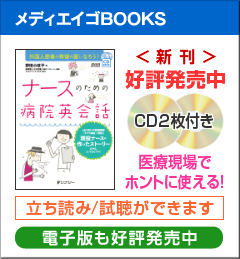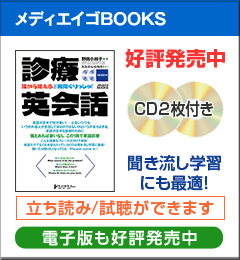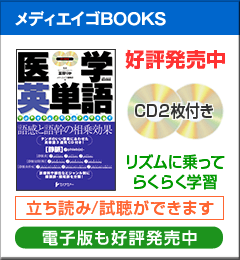

医学にも詳しいバイリンガル・パーソナリティのスマイリーが,ホットな話題を英語のニュースリリースを元に紹介する音声(ポッドキャスト)番組です。完全なネイティブではない,ちょっとくせのあるパワフル英語がやみつきになるかもしれませんよ。番組で取り上げるニュースリリースの全文も掲載しているので,ぜひご活用ください。
英語と日本語のチャンポンで不定期にお届けします。
Please enjoy this bilingual news program!
※iPhone, iPadでは「Download」をタップすると音声が出ます。
Jul. 24, 2012
No. 4
米国臨床腫瘍学会より:乳がんの新たな分子標的薬
新規の分子標的薬 T-DM1により,進行したHER2陽性乳がん患者の無増悪生存期間が延長(EMILIA試験)
|
Get the Flash Player to see this player.
|
 |
・progression-free survival(PFS):無増悪生存期間
・thrombocytopenia:血小板減少
・dose-limiting toxicity:用量制限毒性
【番組で取り上げた英文】
A phase III randomized study of the investigational agent trastuzumab emtansine (T-DM1) vs. standard therapy using capecitabine and lapatinib found significant and clinically meaningful improvement in progression-free survival (PFS) for T-DM1 in women with HER2-positive locally advanced or metastatic breast cancer previously treated with a taxane and trastuzumab.
The median PFS for patients receiving T-DM1 was 9.6 months, compared to 6.4 months in the group receiving capecitabine and lapatinib (a regimen known as XL) -- a difference that was statistically significant. After two years, 65.4 percent of the T-DM1 patients were alive, compared to 47.5 percent of the XL patients.
The most common adverse events of Grade 3 or above for T-DM1 included thrombocytopenia (12.9 percent vs. 0.2 percent) and elevation in liver function tests. These side effects resolved when patients took a break from the drug.
As a clinician who takes care of a lot of breast cancer patients, I’m pleased that this drug has very little dose-limiting toxicity. Patients don’t lose their hair from this drug. For patients facing metastatic breast cancer, this is a breakthrough.
【ニュースリリース全文】 ※番組で取り上げた箇所は太字になっています。
News Release from American Society of Clinical Oncology on June 3, 2012
New Treatment for HER2-Positive Advanced Breast Cancer, Trastuzumab Emtansine, Improves Progression-Free Survival Over Current Standard
CHICAGO (June 3, 2012) -- A phase III randomized study of the investigational agent trastuzumab emtansine (T-DM1) vs. standard therapy using capecitabine (Xeloda) and lapatinib (Tykerb) found significant and clinically meaningful improvement in progression-free survival (PFS) for T-DM1 in women with HER2-positive locally advanced or metastatic breast cancer previously treated with a taxane and trastuzumab.
T-DM1 is an experimental antibody-drug conjugate that consists of the antibody trastuzumab (Herceptin) linked to the cytotoxic drug emtansine (DM1). T-DM1 has not been approved by the Food and Drug Administration, and is not yet available outside of clinical trials.
“The drug worked. It was significantly better than a very effective approved therapy for HER2 overexpressing metastatic breast cancer,” said lead study author Kimberly L. Blackwell, MD, professor of medicine and assistant professor of radiation oncology at Duke Cancer Institute at Duke University. “Also, as a clinician who takes care of a lot of breast cancer patients, I’m pleased that this drug has very little dose-limiting toxicity. Patients don’t lose their hair from this drug. For patients facing metastatic breast cancer, this is a breakthrough.”
The international study, called EMILIA, randomized nearly 1,000 patients to receive either T-DM1 or XL every three weeks until their disease progressed or they experienced unmanageable toxicity.
The median PFS for patients receiving T-DM1 was 9.6 months, compared to 6.4 months in the group receiving capecitabine and lapatinib (a regimen known as XL) – a difference that was statistically significant.
After two years, 65.4 percent of the T-DM1 patients were alive, compared to 47.5 percent of the XL patients. This difference in statistical significance did not meet the trial’s predetermined statistical survival threshold for the first analysis. The second planned survival analysis planned for later in the study will provide additional information.
The most common adverse events of Grade 3 or above for T-DM1 included thrombocytopenia (12.9 percent vs. 0.2 percent) and elevation in liver function tests. These side effects resolved when patients took a break from the drug, Dr. Blackwell said. Dose reductions were greater for patients in the XL group: 53.4 percent for capecitabine, 27.3 percent for lapatinib, and 16.3 percent for T-DM1.
Patients in the XL group experienced more diarrhea (20.7 percent vs. 1.6 percent), hand-foot syndrome (redness, swelling, and pain on the palms of the hands or the soles of the feet) (16.4 percent vs. 0), and vomiting (4.5 percent vs. 0.8 percent).



